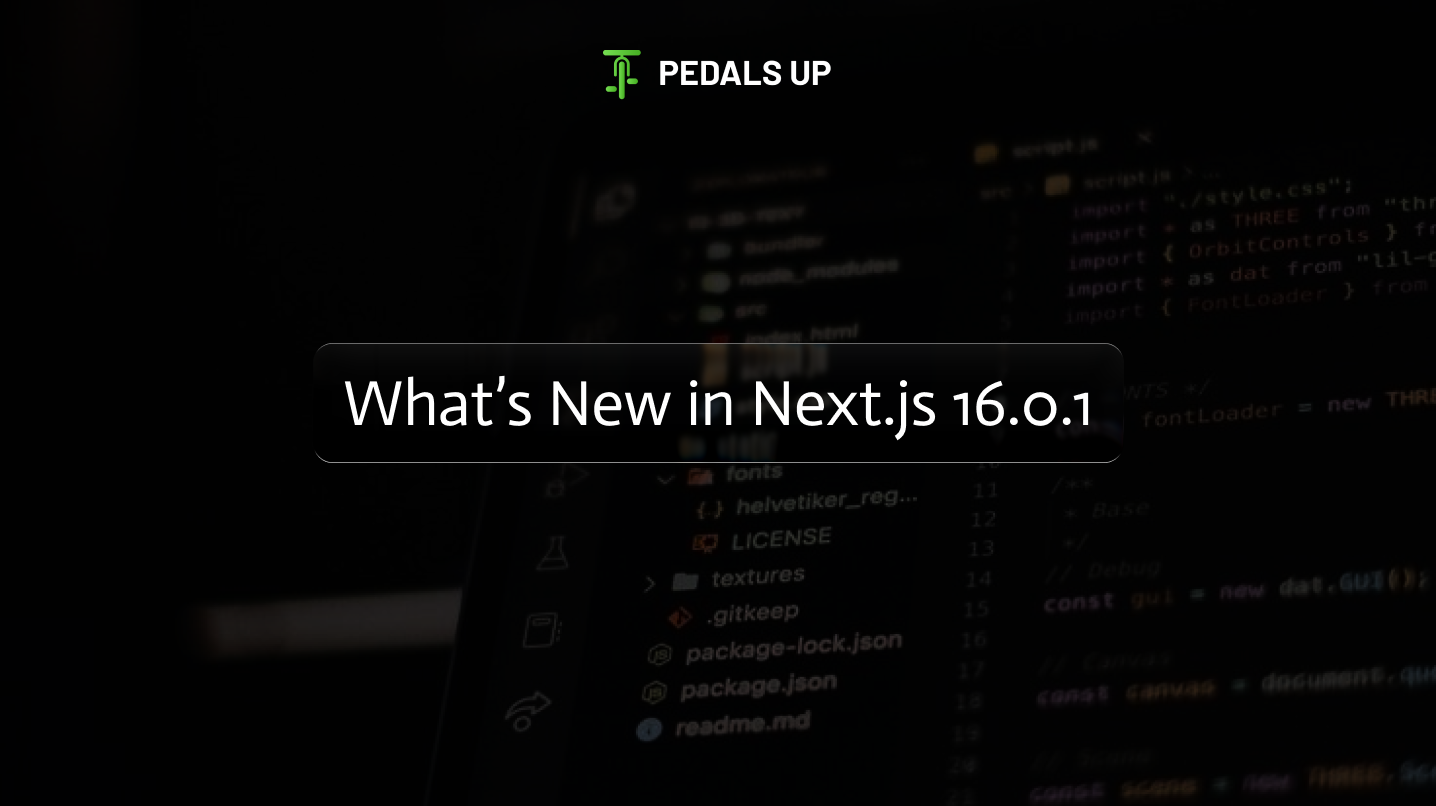Introduction
Next.js has long addressed many of these pain points as an extension to React. With its file-system routing, hybrid rendering, and strong developer experience, it has become a premier choice for building production-grade web applications. The release of Next.js 16.0.1 strengthens this foundation with significant improvements in performance, caching, routing, and developer productivity.
Below is an overview of what’s new, why these updates matter for engineering teams, and how organizations can upgrade or adopt this version to build fast, scalable, and maintainable web apps.
What’s New in Next.js 16.0.1
Next.js 16.0.1 brings significant improvements in build tooling, navigation, caching, runtime execution, and configurability. These combined upgrades result in better developer workflows, superior performance in production, and significantly easier application maintenance.
Turbopack by Default
The most impactful update is the transition of Turbopack from experimental to becoming the default bundler for new Next.js apps. While Webpack was the reliable default, it introduced slow build times in large applications. Turbopack, written in Rust, offers vastly improved performance.
- Highlights:
- Faster production builds
- Faster development refresh cycles
- Better incremental build performance
These improvements are crucial for big codebases and monorepos where minimal changes often trigger heavy compilation. Shorter feedback loops mean quicker iteration cycles, directly reducing time-to-delivery and operational overhead for organizations running continuous deployment.
Improved Caching System
Next.js has always supported server-side rendering and Incremental Static Regeneration (ISR). However, past caching behavior could sometimes feel unpredictable, especially with frequently changing dynamic content.
Next.js 16.0.1 addresses this by introducing:
- Cache Components
- Updated caching APIs: revalidateTag(), updateTag()
- More explicit cache lifecycles
This makes caching easier to understand, implement, and optimize, leading to:
- Predictable cache management
- Safer handling of dynamic data
- Reduced risk of stale responses
- Less unnecessary data re-fetching
Common Use Case: Developers can set up a frequently-updating product feed that is served fast from the cache, updated in the background, and refreshed immediately when new data is available. This allows for responsive UIs without compromising on data accuracy.
Improved Routing & Navigation
Version 16.0.1 improves routing to support faster and more efficient navigation, especially in applications with deeply nested layouts.
- Key Changes:
- Layout deduplication
- Incremental prefetching
- Smarter prefetch execution
- Why It Matters:
- Reduced bundle size on navigation
- Smoother transitions between pages
- Lower bandwidth usage
- Better UX on slow networks
Example: If several pages share the same layout, the browser fetches this layout once, instead of repeatedly fetching it for every route. This is very useful for enterprise dashboards and e-commerce websites.
React Compiler Support
Next.js 16.0.1 includes the React Compiler. It performs content-aware analysis of components and automatically memoizes them, reducing reliance on manual methods like React.memo or useMemo to prevent unnecessary re-renders.
- Advantages:
- Less boilerplate code
- Reduced CPU usage
- Faster UI updates
This is particularly useful for applications involving interactive data visualization, frequent state updates, or large component trees.
Developer Experience Enhancements
The Next.js team continues to invest in tooling and configurability:
- Better logging and diagnostics
- Improved DevTools Integration
- Build Adapters API (alpha)
The Build Adapters API (though still early) enables teams to run Next.js in custom environments, offering advanced flexibility to tailor build outputs to infrastructure needs. Better tooling ensures more efficient debugging and faster issue resolution.
Real-World Impact

A mid-size SaaS company migrated from Next.js 15 to 16.0.1 and reported significant improvements:
Metric | Before (Next.js 15) | After (Next.js 16.0.1) |
Production Build Time | 10–12 minutes | ~4 minutes |
Client Navigation Time | ~2.5 seconds | ~1.2 seconds |
Bounce Rate | – | 15% decrease |
Signup Conversion | – | 10% increase |
The reduction in build time increased deployment velocity. Faster client navigation improved UX, especially on mobile networks, leading to measurable increases in conversions.
Why Performance Matters: Industry research shows that even an improvement of 0.1 second in page speed can increase conversion rates by about 1%. Optimizations in Turbopack, caching, navigation, and rendering come with quantifiable business benefits, improving SEO, reducing user friction, and enabling better engagement. (Further reading: https://web.dev/)
Migration Guide: Upgrading to Next.js 16.0.1
Following is a practical migration approach suitable for an engineering team:
Step 1 — Audit
- Verify current versions of next, react, and react-dom.
- Capture baseline metrics: build times, Core Web Vitals, and navigation latency.
Step 2 — Upgrade
Install new versions:
Bash
npm install next@latest react@latest react-dom@latest
Step 3 — Update Config
- Review next.config.js for deprecated settings.
- Adopt new caching controls (revalidateTag, etc.).
- Validate server endpoints.
Step 4 — Test
During QA, check the following:
- Layout rendering behavior
- Prefetching operations
- Cache revalidation
- Navigation under slow networks
- Form operations and SSR behavior
Step 5 — Monitor
After migration, continuously monitor build performance, Core Web Vitals, and changes to metrics for the conversion funnel.
Engineering Team Benefits
Next.js 16.0.1 offers significant advantages:
- Faster builds and faster refresh
- Clearer and more predictable caching
- Fewer unnecessary UI re-renders
- Cleaner and more composable code
- Improved navigation performance
These improvements enable faster iteration, easier performance optimization, and enhanced reliability in production, helping teams deliver more value with less effort.
Conclusion
Next.js 16.0.1 is full of improvements that take developer experience and production performance to the next level. Out-of-the-box integration with Turbopack, the improved caching model, enhanced routing, and support for the React Compiler all empower teams to build high-performance apps with fewer trade-offs.
For organizations seeking to modernize their frontend architecture and improve development velocity, Next.js 16.0.1 offers a strong path forward.




